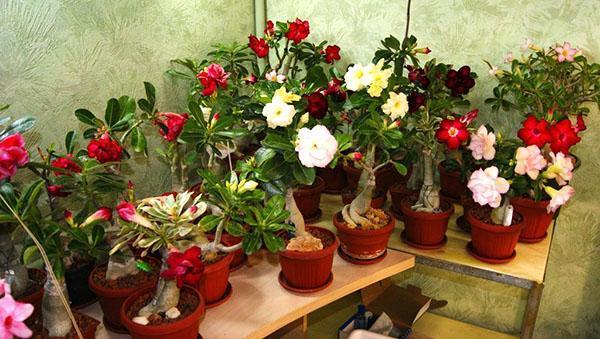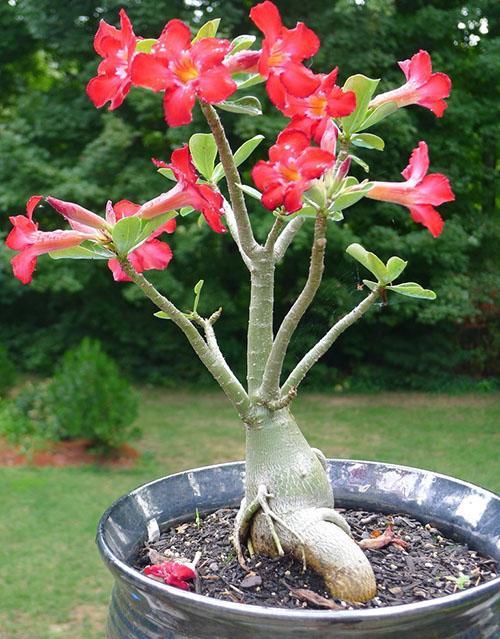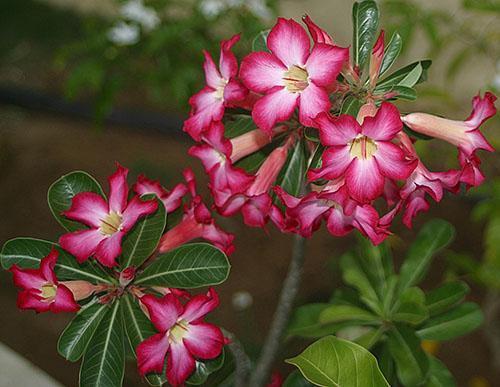Photo describing the types and varieties of adenium at home

In nature, adeniums are perennial tree-like plants or shrubs that grow in the arid hot regions of central and southern Africa, the Arabian Peninsula and Socotra Island. Adenium at home is a spectacular indoor flower that instantly attracts attention with its unusual thickened stem, dense leaves at the tops of the shoots and bright flowering. During the growing season, varietal plants are decorated with simple and terry corollas in white, pink, raspberry-red and crimson tones.
Thanks to the flowers, unexpectedly lush for the succulent, the culture received a second name, adenium "desert rose", and became incredibly popular with flower growers all over the world.
For the first time, botanists were interested in adenium back in the 18th century, when the first attempt was made to classify its species, but there are still many discrepancies in the accepted system in the scientific community. It is generally accepted to distinguish 10 types of adeniums, differing:
- the shape of caudex, flowers and leaves;
- dimensions;
- peculiarities of vegetation;
- a place of natural growth.
Despite the visible differences, some cultural experts believe that all existing varieties belong to the same type of adenium obessum, and variations in appearance are caused by climatic, soil or other differences.
Adenium obessum (A. Obesum)

The name adeniums are obliged to Aden, or present-day Yemen, where this extraordinary plant was first described.
 For adenium obesum resistant to drought, high air temperatures and direct sunlight, periods of wakefulness and rest are characteristic, when a perennial:
For adenium obesum resistant to drought, high air temperatures and direct sunlight, periods of wakefulness and rest are characteristic, when a perennial:
- sheds elongated, leathery to the touch, gray-greenish leaves 6 to 15 cm long;
- stops growing;
- does not form new colors.
This condition is observed during the cold season and during dry seasons. With the beginning of the growing season, young foliage appears on the tops of the shoots. In the summer, buds appear, turning into tubular flowers of crane and pink shades. The diameter of the 5-petal corolla in wild-growing obese adenium ranges from 4 to 7 cm, varietal flowers are much larger, up to 12 cm, and more diverse in color and shape.
 The thickened grayish-brown stem can grow up to a meter thick, while a significant part of the caudex is located under the soil, and the trunk of obese adenium remaining outside takes the form of a tree or shrub up to three meters high.
The thickened grayish-brown stem can grow up to a meter thick, while a significant part of the caudex is located under the soil, and the trunk of obese adenium remaining outside takes the form of a tree or shrub up to three meters high.
Due to its slow growth, limitation by the size of the pot, and also thanks to the pruning and shaping of the house, adenium is unlikely to grow to such a size, but it will please with bizarre shapes and bright colors.
Adenium multiflorum (A. Multiflorum)
 The homeland of the plant, which strikes with especially abundant flowering, is the central and southern regions. Here the multiflorous adenium prefers to settle on sandy and saline soil.
The homeland of the plant, which strikes with especially abundant flowering, is the central and southern regions. Here the multiflorous adenium prefers to settle on sandy and saline soil.
The unpretentious species is content with small accumulations of soil and is not afraid of drought, conserving moisture reserves inside a thickened trunk resembling a miniature baobab tree with a smooth grayish bark and powerful roots hidden under the soil.
In nature, plants of adenium multiflora can reach three meters in height and in many countries are under state protection due to the risk of extinction. The species are threatened by lovers of exotic crops hunting lush flowering specimens, livestock and monkeys that feed on plant tubers.
 Thanks to the incredible abundance flowers adenium received the name Impala lily, but in culture this species is less common than obese adenium, due to slow growth and the beginning of flowering after 4 years of age.
Thanks to the incredible abundance flowers adenium received the name Impala lily, but in culture this species is less common than obese adenium, due to slow growth and the beginning of flowering after 4 years of age.
Adenium arabicum (A. Arabicum)
 The name of adenium arabicum speaks for itself. This species with a massive, squat caudex grows in the Arabian Peninsula.
The name of adenium arabicum speaks for itself. This species with a massive, squat caudex grows in the Arabian Peninsula.
Depending on the climatic conditions, the appearance of the plant can change. In areas with chronic droughts, adeniums are bush-shaped, where there is more moisture, they can look like strong, thick trees at the base with weakly pronounced branches. Adenium arabicum has rather large leaves, pinkish, with a purple tint or dark brown bark and reddish-pink flowers.
At home, adenium arabic can be grown from seeds in order to subsequently start forming its caudex and trunk.
Adenium Somali (A. Somalense)
 The Somali species of adenium is an indigenous inhabitant of Africa, growing in different areas of its range to a height of one and a half to five meters. The plant is characterized by a conical trunk and almost continuous flowering, if the plant manages to provide sufficient sun.
The Somali species of adenium is an indigenous inhabitant of Africa, growing in different areas of its range to a height of one and a half to five meters. The plant is characterized by a conical trunk and almost continuous flowering, if the plant manages to provide sufficient sun.
The green elongated leaves are bright green in color. White or light streaks are often visible on the leaf blade. For the winter, plants lose their foliage and need rest. Small petals with narrower petals than those of obese adenium appear on thin branches. The color of the 5-petal corollas is pink, crimson, red with lightening towards the neck. The species can interbreed with obessum adenium, which is what many breeders use. In addition, the Somali variety is easy to grow, seedlings bloom for the first time in a year or a half after planting, when the stem rises to a height of 15-18 cm.
Adenium crispum (A. somalense var crispum)
 Adenium crispum, considered a subspecies of the Somali plant, looks very decorative. A characteristic feature of the culture is the narrow, long leaves with whitish veins and twisted edges, which gave the name to this variety, as well as the underground part of the caudex that resembles a turnip. Numerous slender roots only increase the resemblance to a root vegetable.
Adenium crispum, considered a subspecies of the Somali plant, looks very decorative. A characteristic feature of the culture is the narrow, long leaves with whitish veins and twisted edges, which gave the name to this variety, as well as the underground part of the caudex that resembles a turnip. Numerous slender roots only increase the resemblance to a root vegetable.
 This type of adenium for the home is interesting not only for the shape of the stem and medium-sized size, but also for the original flowers that do not look like the flowers of Somali adenium. Pink, less often red corollas are wide open, petals have a noticeable bend.
This type of adenium for the home is interesting not only for the shape of the stem and medium-sized size, but also for the original flowers that do not look like the flowers of Somali adenium. Pink, less often red corollas are wide open, petals have a noticeable bend.
Adenium nova, Tanzanian (A. somalense var. Nova)
 One of the recently described subspecies of the Somali species comes from the semi-deserts of Tanzania and surrounding regions. In the adenium crispum, this plant has a similar appearance to the leaves, and the pink or reddish corollas are more reminiscent of the flowers of the Somali adenium.
One of the recently described subspecies of the Somali species comes from the semi-deserts of Tanzania and surrounding regions. In the adenium crispum, this plant has a similar appearance to the leaves, and the pink or reddish corollas are more reminiscent of the flowers of the Somali adenium.
Adenium boehmianum (A. boehmianum)
 At the end of the 19th century, botanists discovered and described the view of Adenium boichmianum from the north of Namibia. This variety is known not so much for its decorativeness, but as a poisonous plant, which has earned the name Bushman's Poison among the local population.
At the end of the 19th century, botanists discovered and described the view of Adenium boichmianum from the north of Namibia. This variety is known not so much for its decorativeness, but as a poisonous plant, which has earned the name Bushman's Poison among the local population.
In nature, strong plants reaching three meters in height readily branch, grow slowly and over time the thickening on the trunk smoothes out. Spirally arranged leaves are found only on the tops of the shoots, have a leathery, 8–15 cm long leaf plate of a silvery-green hue with well-visible veins.
 Corollas almost rounded due to wide petals can be pink, lilac, crimson. A characteristic feature of the adenium flower of this species is the rich purple color of the neck.
Corollas almost rounded due to wide petals can be pink, lilac, crimson. A characteristic feature of the adenium flower of this species is the rich purple color of the neck.
Adenium swazicum (A. swazicum)
 The name of adenium reflects its place of origin - Swaziland. Bush-shaped plants with a height of 20 to 50 cm outwardly bear little resemblance to their relatives, since only a few grayish or light green shoots with narrow long leaves and 6-cm flowers of pink or lilac paint are visible above the ground. Powerful rhizomes are hidden underground and are practically invisible in adult plants.
The name of adenium reflects its place of origin - Swaziland. Bush-shaped plants with a height of 20 to 50 cm outwardly bear little resemblance to their relatives, since only a few grayish or light green shoots with narrow long leaves and 6-cm flowers of pink or lilac paint are visible above the ground. Powerful rhizomes are hidden underground and are practically invisible in adult plants.
At home, adenium Swaziland blooms for a long time and willingly, rarely sheds foliage, is unpretentious and cold-resistant. It is not surprising that this species is readily used by breeders to obtain interspecific hybrids with obesum adenium.
Adenium oleifolium (A. oleifolium)
 African adenium oleifolium differs from its "brothers" in extremely slow growth and modest size. A bush with powerful, thick rhizomes and a smooth trunk reaches a height of 60 cm.
African adenium oleifolium differs from its "brothers" in extremely slow growth and modest size. A bush with powerful, thick rhizomes and a smooth trunk reaches a height of 60 cm.
The narrow leaves, 5 to 12 cm long, are painted in greenish-olive tones and are located on the tops of the branches. Pink adenium flowers can have a yellow or white center. The opening of the buds collected in inflorescences occurs simultaneously with the appearance of foliage.
Socotran adenium (A. socotranum)
 On the island of Socotra in the Indian Ocean, an endemic species of adenium grows, according to the description, not found in other parts of the range of this plant. Compared to domestic adeniums, this is a true giant that grows up to 5 meters in height.
On the island of Socotra in the Indian Ocean, an endemic species of adenium grows, according to the description, not found in other parts of the range of this plant. Compared to domestic adeniums, this is a true giant that grows up to 5 meters in height.
A bottle-like barrel can consist of several fused parts, on which transverse stripes are necessarily noticeable. The branches are incomparably thinner than the main trunk. They are thin and fragile, crowned with dark green, with white veins, shiny leaves up to 12 cm long. Light pink adenium flowers have a diameter of 10–12 cm; a brighter border runs along the edge of the petals.
Hybrids and varieties of adenim for home cultivation
Although the homeland of adenium is the hot expanses of Africa and the Middle East, completely different regions have become the centers of breeding and selection of these plants. The main suppliers of new varieties and hybrids are the countries of Southeast Asia, Thailand, India, Malaysia, and the Philippines.
 The local climate is great for breeding crops. Bonsai exhibitions are often held here based on adenium, from here seeds and seedlings are scattered all over the world.
The local climate is great for breeding crops. Bonsai exhibitions are often held here based on adenium, from here seeds and seedlings are scattered all over the world.
Today, flower growers are especially interested in Mini Size adeniums, which are comfortable for home, with a height of only 12–17 cm. Such crumbs begin to bloom at the age of 2, revealing 6-centimeter flowers at the tips of the shoots.
 Another object of understandable interest is the variegated forms of adenium with variegated foliage or completely discolored leaves.
Another object of understandable interest is the variegated forms of adenium with variegated foliage or completely discolored leaves.
At the disposal of florists today there are many hybrid plants and varieties of adenium with simple, double, monochromatic and variegated flowers. However, it is not uncommon for sellers who enjoy the huge popularity of the plant, wishful thinking and suggesting known fake varieties.